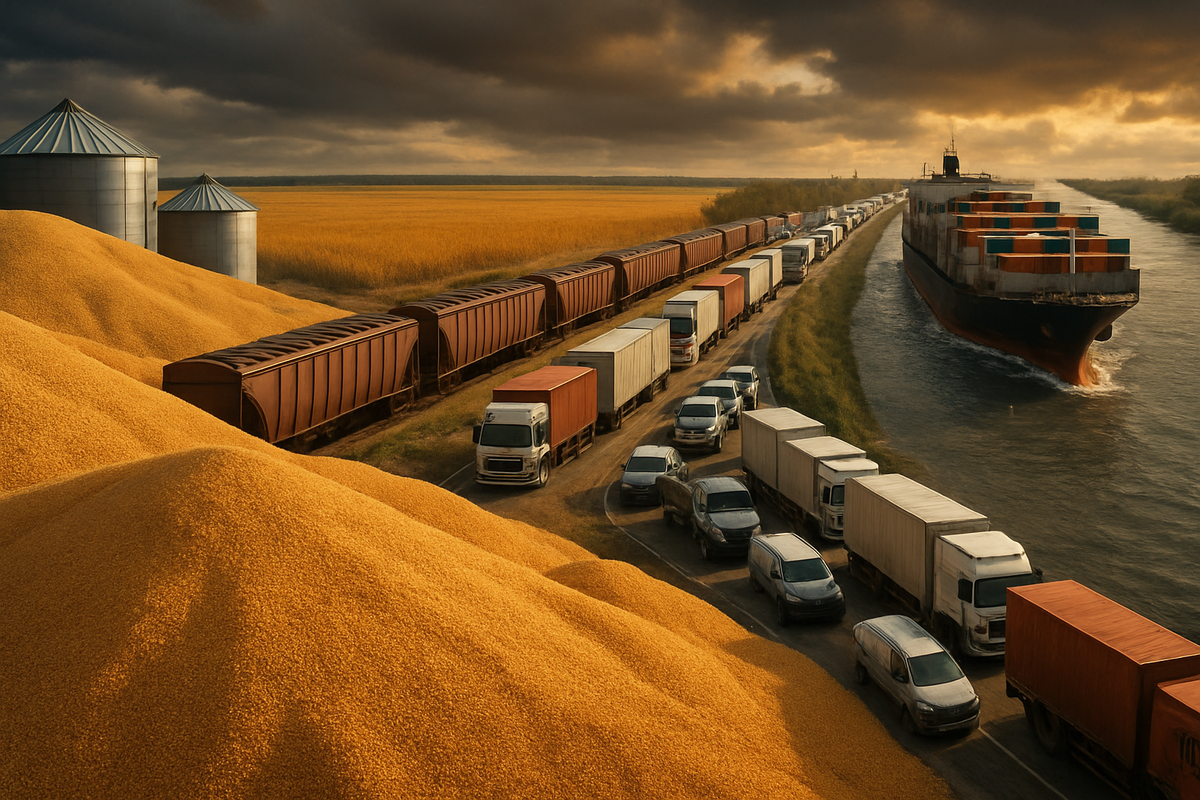
October 6, 2025 – The global agricultural landscape is grappling with an unprecedented challenge: a projected record grain harvest colliding with a fractured and inefficient export market. This perfect storm has triggered an immediate and severe scramble for storage and transportation logistics, creating bottlenecks that threaten to depress commodity prices and squeeze profitability for producers worldwide. As mountains of freshly harvested grain await shipment, the intricate web of global supply chains is being stretched to its breaking point, with far-reaching implications for food security and the financial health of agricultural giants and smallholder farmers alike.
The immediate fallout is a dramatic tightening of storage capacity, particularly across the United States, where bumper crops of corn, soybeans, and wheat are overwhelming existing infrastructure. Concurrently, persistent disruptions in key shipping routes, notably the Red Sea crisis and historically low water levels in the Panama Canal, continue to snarl international trade. While some regions experience robust demand, others, like the U.S. soybean market facing reduced Chinese imports, are seeing significant slowdowns. This uneven demand exacerbates the logistical nightmare, forcing producers and merchandisers to navigate a complex environment of oversupply, fragmented export opportunities, and escalating operational costs.
The Perfect Storm: Record Yields Meet Logistical Gridlock
The current predicament stems from a confluence of factors that have been building throughout 2025. Global total grains production for the 2025/26 season is forecast to reach a new record of 2,373 million tonnes, a substantial 70 million tonne increase year-on-year, primarily driven by an exceptionally strong maize (corn) harvest. The United States, a pivotal player, is anticipating a monumental harvest totaling 21.5 billion bushels of corn, soybeans, and grain sorghum. The U.S. Department of Agriculture (USDA) projects a record-large corn crop, potentially exceeding 186 bushels per acre. Similar surges are expected in the EU, with a 6% increase in total grain output, and Brazil, forecasting an 8.2% rise in grain production led by soybeans. Overall, global grain production is projected to increase by 3% in 2025.
However, this abundance is met with a paradox of uneven export demand. While U.S. corn and wheat exports have seen a robust year, reaching a record $80 billion due to competitive pricing and strong demand from regions like Mexico, Japan, and the Middle East, U.S. soybean and grain sorghum exports are significantly lagging. Soybean sales are down 51% year-over-year, largely attributed to reduced demand from China, which is increasingly prioritizing grain self-sufficiency and diversifying its sourcing away from the U.S. market. This shift, coupled with lingering trade tensions and tariffs, has profoundly impacted American producers.
The timeline leading to this crunch began with favorable weather conditions throughout the growing season, promising bumper yields. As harvest season commenced in late summer and early fall of 2025, the sheer volume of incoming grain quickly exposed the vulnerabilities in the storage and transportation network. Key players involved in this intricate dance include millions of farmers globally, major agricultural trading houses like Archer Daniels Midland (NYSE: ADM) and Bunge Global SA (NYSE: BG), grain elevator operators, railroad companies such as Union Pacific Corporation (NYSE: UNP) and CSX Corporation (NASDAQ: CSX), trucking companies, and port authorities. Governments and international bodies also play a crucial role in trade policy and infrastructure development. Initial market reactions have been swift and largely negative for grain prices, with wheat futures declining to their lowest in over a year and corn futures falling below $4 per bushel, a level often deemed unprofitable for many producers. The international grain market started October with broad declines, influenced by the USDA's upward revisions of U.S. supply and stocks. This has led to weakened "basis" levels—the difference between local cash prices and futures prices—in many regions, further squeezing farmer margins.
Corporate Crossroads: Winners and Losers in the Grain Glut
The current market dynamics present a mixed bag for public companies operating within the agricultural and logistics sectors. Some stand to gain from the increased volume and logistical challenges, while others face significant headwinds.
Potential Winners:
- Agricultural Trading Houses (with robust logistics): Companies like Archer Daniels Midland (NYSE: ADM) and Bunge Global SA (NYSE: BG), with extensive global networks of elevators, processing plants, and shipping capabilities, are strategically positioned. While depressed prices might affect their merchandising margins, the sheer volume of grain needing to be moved, stored, and processed could boost their logistics and processing segments. Their ability to arbitrage regional price differences and manage complex supply chains becomes invaluable. Those with significant storage capacity, particularly temporary storage solutions, could charge higher fees.
- Railroad Companies: Union Pacific Corporation (NYSE: UNP) and CSX Corporation (NASDAQ: CSX), which transport vast quantities of grain from farms to export terminals or processing facilities, could see increased demand for their services due to the sheer volume. Despite some localized bottlenecks, the overall need for long-haul transportation will be high. However, their profitability will depend on their ability to manage capacity efficiently and avoid severe congestion.
- Storage Solution Providers: Companies that manufacture or provide temporary grain storage solutions, such as grain bags or portable bunkers, may see a surge in demand as traditional elevator capacity overflows.
- Specialized Logistics and Port Operators: Those with efficient port operations and strong inland connectivity, capable of handling large volumes despite global shipping disruptions, could gain market share.
Potential Losers:
- Farmers: Small to medium-sized farmers are perhaps the most vulnerable. Depressed grain prices, coupled with high input costs (fertilizer, fuel, seeds), will severely squeeze profit margins. Many will struggle to cover their production expenses, and the lack of accessible, affordable storage could force them to sell at unfavorable cash prices. The widening "basis" further compounds their financial woes.
- Grain Elevator Operators (without sufficient capacity): Local grain elevators that lack the capacity to handle the surge, or those heavily reliant on specific export markets that have weakened (e.g., U.S. soybean elevators dependent on China), will face operational challenges and potential revenue declines. They may incur additional costs for managing overflow and risk grain deterioration in temporary storage.
- Shipping Companies (facing Red Sea/Panama Canal issues): While some dry bulk freight rates have been soft, companies heavily reliant on the disrupted Red Sea and Panama Canal routes continue to incur higher costs due to rerouting, increased fuel consumption, and extended transit times. This makes the global movement of grain more expensive and less predictable.
- Commodity Processors (with rigid supply chains): While overall low grain prices can be a boon for processors, those with rigid supply chains that cannot adapt to shifting sourcing patterns or transportation bottlenecks might face higher operational costs or delays in securing raw materials.
Broader Implications: A Shifting Agricultural Paradigm
This convergence of a record harvest and logistical disarray is not merely a short-term market blip; it signals a deeper, evolving paradigm within the global agricultural industry. The event underscores the increasing volatility and interconnectedness of food supply chains, where local production surpluses can have global ripple effects, and geopolitical tensions can directly impact commodity flows.
This situation fits into broader trends of climate change-induced weather variability, leading to more frequent instances of both bumper crops and devastating droughts, and the ongoing geopolitical fragmentation impacting trade routes and relationships. China's strategic pivot towards grain self-sufficiency and diversified sourcing, for example, is a long-term trend that will continue to reshape global agricultural trade, reducing reliance on single suppliers like the U.S. for certain commodities.
The potential ripple effects are extensive. Competitors in other grain-producing regions, such as Brazil, Argentina, and the Black Sea nations, may see opportunities to fill gaps in demand or gain market share if U.S. exports remain hampered by logistics or trade policies. Partners in the logistics sector, from port operators to trucking firms, will need to invest heavily in infrastructure and technology to enhance efficiency and resilience. Regulatory and policy implications are also significant. Governments may face pressure to subsidize storage solutions, invest in transportation infrastructure, or re-evaluate trade agreements to alleviate the current bottlenecks and support farmers. There could be renewed calls for strategic grain reserves to buffer against future shocks.
Historically, periods of oversupply have often led to government intervention, such as price support programs or export subsidies, to stabilize farmer incomes. The current situation echoes past agricultural gluts, but with added complexity from modern globalized supply chains and geopolitical instability. For instance, the U.S. farm crises of the 1980s, driven by overproduction and declining exports, serve as a stark reminder of the devastating impact of such imbalances on rural economies. The key difference today is the global scale of both production and logistical challenges, making a coordinated international response more critical, yet harder to achieve.
The Road Ahead: Navigating Volatility and Seeking Resilience
Looking ahead, the short-term outlook for the grain market remains challenging, characterized by continued price pressure and logistical headaches. Farmers will be forced to make difficult decisions regarding storage versus immediate sales, potentially leading to further strain on cash flow. In the long term, however, this crisis could catalyze significant strategic pivots and adaptations across the industry.
We can expect to see increased investment in on-farm storage solutions and temporary storage options, as producers seek greater control over their inventory and marketing decisions. Agricultural technology companies offering solutions for grain quality monitoring in temporary storage will likely see increased demand. Furthermore, there will be a renewed focus on optimizing inland transportation networks, potentially involving greater coordination between rail, truck, and barge operators, and investment in multimodal hubs. Port infrastructure may also see upgrades to handle larger volumes more efficiently.
Market opportunities may emerge for those with the foresight and capital to invest in distressed assets or expand their logistical capabilities. Companies that can offer integrated solutions—from storage to processing to export—will likely gain a competitive edge. The crisis could also accelerate the adoption of digital platforms for supply chain management, offering greater transparency and efficiency.
Potential scenarios range from a rapid rebalancing, if export demand unexpectedly surges or logistical issues are quickly resolved, to a prolonged period of low prices and storage woes if current conditions persist. A critical factor will be the evolution of trade relations, particularly with China, and the stability of international shipping lanes. Investors should watch for policy announcements from major agricultural nations, infrastructure spending plans, and the quarterly reports of major agricultural and logistics companies for insights into their adaptation strategies and financial performance. The ability of these companies to manage inventory, secure favorable freight rates, and diversify their customer base will be crucial.
Wrap-Up: A Call for Adaptability and Strategic Vision
The current confluence of a record global grain harvest and uneven, disrupted export logistics represents a pivotal moment for the agricultural and commodity markets. The immediate takeaways are clear: an unprecedented strain on storage and transportation infrastructure, downward pressure on grain prices, and significant financial challenges for producers. This event underscores the fragility of global supply chains in the face of both abundance and geopolitical instability.
Moving forward, the market will demand greater adaptability, resilience, and strategic vision from all stakeholders. Farmers must become more adept at managing price risk and storage. Agricultural trading houses and logistics providers will need to innovate and invest in more robust, flexible networks. Governments will face pressure to support their agricultural sectors and ensure food security through infrastructure development and trade policy.
The lasting impact of this period will likely be a re-evaluation of global agricultural strategies, emphasizing diversified markets, resilient logistics, and a greater understanding of the complex interplay between production, trade, and geopolitics. Investors should closely monitor indicators such as global stock-to-use ratios, regional basis levels, freight rates, and trade policy developments. The companies that can effectively navigate this turbulent environment, leveraging technology and strategic partnerships, will be the ones that emerge stronger, shaping the future of global food trade for years to come.
This content is intended for informational purposes only and is not financial advice.






